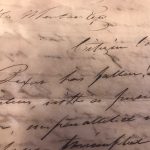by Rachel DeShong, Special Event Coordinator and Map Curator
This blog post is the third and final post in a series of three highlighting John Melish, a 19th century cartographer, and the impact his 1816 map, Map of the United States with the Contiguous British & Spanish Possessions, had on U.S. history.
As the United States acquired significant territory through the 1840s and 1850s, borders between newly admitted states followed boundaries established in the Adams-Onís Treaty of 1819. Border disputes between states emerged as a result of several inaccuracies in Melish’s map. One particular hotbed of contention was the Red River area.
According to the Adams-Onís Treaty, the boundary between the Spanish colony of Mexico and the United States began at the mouth of the Sabine River, went north to the 32nd degree latitude line where it intersected with the Red River, and then followed that river west until it reached the 100th Meridian. However, there were several problems with Melish’s depiction of the area. Firstly, his 100th Meridian was off target by nearly 90 miles. Secondly, Melish only recorded a single fork in the Red River while, in actuality, there were two. These errors became problematic in deciphering the border between Texas and the Indian Territory (Oklahoma).


 Bexar has fallen! Our brave citizen volunteers, with a persevering bravery and heroic valor, unparalleled in the annals of warfare, have triumphed over a force of twice their number and compelled the slaves of despotism to yield, vanquished by the ever resistless arms of freemen soldiers.
Bexar has fallen! Our brave citizen volunteers, with a persevering bravery and heroic valor, unparalleled in the annals of warfare, have triumphed over a force of twice their number and compelled the slaves of despotism to yield, vanquished by the ever resistless arms of freemen soldiers.



